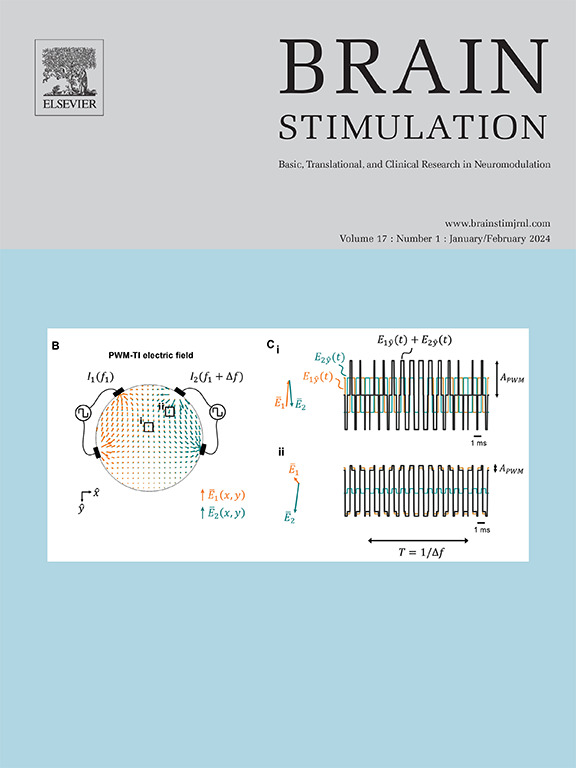丘脑下核深部脑刺激治疗颅颈肌张力障碍:最佳刺激部位和网络。
IF 8.4
1区 医学
Q1 CLINICAL NEUROLOGY
引用次数: 0
摘要
背景与目的:颅底核深部脑刺激(DBS)是治疗难治性颅颈肌张力障碍(CCD或Meige综合征)的有效方法。然而,临床反应在个体之间存在很大差异,可能是由于电极放置和目标神经回路调节的差异。方法:回顾性分析51例单中心STN-DBS治疗的CCD患者。术前和术后成像用于重建电极位置和模拟患者特异性电场。然后,我们进行了(i)体素甜蜜点映射,以确定最佳刺激部位;(ii)纤维过滤,使用规范的神经束造影来确定与临床改善相关的白质通路;(iii)基于静息状态fMRI的网络映射,以确定预测DBS反应的功能连接模式。结果:体素相关分析显示,最佳刺激定位于STN运动亚区(R = 0.52, p < 0.001)。规范结构连通性分析显示,症状改善与投射到感觉运动皮层颅颈区域的纤维调节(R = 0.52, p < 0.001)和感觉运动相关的基底神经节通路(R = 0.62, p < 0.001)密切相关。功能网络映射进一步显示,与感觉运动皮层的连通性与临床改善显著相关(R = 0.43, p = 0.002)。结论:这些发现为DBS治疗CCD的STN靶向策略的改进提供了依据。颅脑和颈部感觉运动区域的累及突出了基于症状的肌张力障碍分类对个体化神经调节方法的重要性。本文章由计算机程序翻译,如有差异,请以英文原文为准。
Subthalamic nucleus deep brain stimulation for cranial-cervical dystonia: optimal stimulation sites and networks
Background and objectives
Deep brain stimulation (DBS) of the subthalamic nucleus (STN) is an effective treatment for medically refractory cranial-cervical dystonia (CCD or Meige syndrome). However, clinical responses vary substantially across individuals, likely due to differences in electrode placement and modulation of target neural circuits.
Methods
We retrospectively analyzed 51 patients with CCD treated with STN-DBS at a single center. Pre- and postoperative imaging was used to reconstruct electrode locations and model patient-specific electric fields. We then performed (i) voxel-wise sweet spot mapping to identify optimal stimulation sites, (ii) fiber filtering using normative tractography to determine white matter pathways associated with clinical improvement, and (iii) network mapping based on resting-state fMRI to identify functional connectivity patterns predictive of DBS response.
Results
Voxel-wise correlation analysis revealed that the optimal stimulation localized to the STN motor subregion (R = 0.52, p < 0.001). Normative structural connectivity analysis showed that symptom improvement correlated strongly with modulation of fibers projecting to the cranial and cervical regions of sensorimotor cortex (R = 0.52, p < 0.001) and sensorimotor-associated basal ganglia pathways (R = 0.62, p < 0.001). Functional network mapping further revealed connectivity to the sensorimotor cortex as significantly associated with clinical improvement (R = 0.43, p = 0.002).
Conclusion
These findings inform refinement of STN targeting strategies in DBS for CCD. The involvement of cranial and cervical sensorimotor regions highlights the importance of symptom-based dystonia classification for individualized neuromodulation approaches.
求助全文
通过发布文献求助,成功后即可免费获取论文全文。
去求助
来源期刊

Brain Stimulation
医学-临床神经学
CiteScore
13.10
自引率
9.10%
发文量
256
审稿时长
72 days
期刊介绍:
Brain Stimulation publishes on the entire field of brain stimulation, including noninvasive and invasive techniques and technologies that alter brain function through the use of electrical, magnetic, radiowave, or focally targeted pharmacologic stimulation.
Brain Stimulation aims to be the premier journal for publication of original research in the field of neuromodulation. The journal includes: a) Original articles; b) Short Communications; c) Invited and original reviews; d) Technology and methodological perspectives (reviews of new devices, description of new methods, etc.); and e) Letters to the Editor. Special issues of the journal will be considered based on scientific merit.
 求助内容:
求助内容: 应助结果提醒方式:
应助结果提醒方式:


